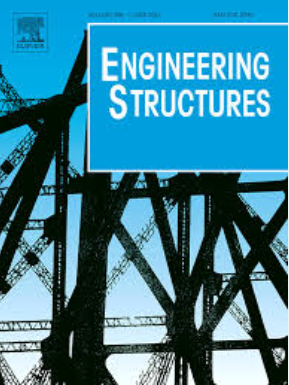考古遗址砌体墙体类型面外破坏机制的脆性曲线:以庞贝的t形构件为重点
IF 6.4
1区 工程技术
Q1 ENGINEERING, CIVIL
引用次数: 0
摘要
评估不同灾害水平作用下考古遗产的安全状况,是保护考古遗产文化价值的关键。即使在低烈度地震作用下,由于构成遗迹的砌体构件之间的连接缺乏或质量差,考古遗迹中的面外破坏机制也很容易被激活。通常用于研究砖石建筑面向对象响应的分析方法可以进行一些修改,以解释考古遗迹的一些特定特征,如不规则形状,缺乏地板,不同建筑材料和技术的重叠,材料经过很长时间的老化。在此框架下,本文将基于极限分析的方法应用于考古遗址中最常见的几种类型的砌体元素,并特别关注庞贝考古公园的类型。根据几种形态学和类型学标准,初步提出了考古墙的分类;它旨在唯一地定义不同的类型及其对几种OOP机制的脆弱性。然后,深入分析了庞贝考古公园中最常见的类型学之一(即t形墙系统);通过改变正交墙之间的相互连接水平,进行了极限分析,研究了几何和力学参数对其简单岩滑机制脆弱性的影响。生成了一个t型墙系统的大型数据库,该数据库具有三个不断增加的连接级别(每种连接类型生成1320个元素的样本),并根据面向对象的地震能力对脆弱性曲线进行了检查。最后,给出了基于几何参数的t型墙体系统子集的脆弱性曲线,以提供同构的面向对象脆弱性类别。这项研究代表了定义一种新的方法方法来评估考古遗迹对OOP机制的地震脆弱性的开始步骤,最终可扩展到任何考古背景。本文章由计算机程序翻译,如有差异,请以英文原文为准。
Fragility curves for out-of-plane failure mechanisms of masonry wall typologies in the archaeological sites: A focus on T-shaped elements in Pompeii
The assessment of the safety conditions of the archaeological heritage under horizontal actions induced by different hazards is crucial to preserve its cultural value. Out-of-plane (OOP) failure mechanisms in archaeological remains can be easily activated, even for low-intensity seismic actions, due to the lack or poor quality of the connections between the masonry elements that compose the remains. The analytical approaches usually adopted to investigate the OOP response of masonry buildings can be used with some modifications to account for some specific features of the archaeological remains, as irregular shapes, lacking floors, overlapping of different construction materials and techniques, ageing of materials over very long time. In this framework, the paper presents the application of a limit analysis-based approach to some typological classes of masonry elements representative of the most frequent ones in archaeological sites, with a specific focus on the typologies in the Pompeii Archaeological Park. A classification of archaeological walls is initially proposed based on a few morphological and typological criteria; it aims at uniquely defining different typologies and their vulnerability to several OOP mechanisms. Then, one of the most recurring typologies in the Pompeii Archaeological Park (i.e., T-shaped wall system) is deeply analysed; limit analysis is carried out to investigate the influence of geometrical and mechanical parameters on its vulnerability to the simple rocking-sliding mechanism, also by varying the level of mutual connections between orthogonal walls. A large database of T-shaped wall systems with three increasing levels of connection is generated (a sample of 1320 elements generated for each connection type) and examined to build fragility curves in terms of OOP seismic capacity. Finally, fragility curves for some subsets of T-shaped wall systems, based on some geometrical parameters, are presented in order to provide homogeneous OOP vulnerability classes. This study represents the kick-off step in defining a new methodological approach to assess the seismic vulnerability of archaeological remains to OOP mechanisms, eventually extendable to any archaeological context.
求助全文
通过发布文献求助,成功后即可免费获取论文全文。
去求助
来源期刊

Engineering Structures
工程技术-工程:土木
CiteScore
10.20
自引率
14.50%
发文量
1385
审稿时长
67 days
期刊介绍:
Engineering Structures provides a forum for a broad blend of scientific and technical papers to reflect the evolving needs of the structural engineering and structural mechanics communities. Particularly welcome are contributions dealing with applications of structural engineering and mechanics principles in all areas of technology. The journal aspires to a broad and integrated coverage of the effects of dynamic loadings and of the modelling techniques whereby the structural response to these loadings may be computed.
The scope of Engineering Structures encompasses, but is not restricted to, the following areas: infrastructure engineering; earthquake engineering; structure-fluid-soil interaction; wind engineering; fire engineering; blast engineering; structural reliability/stability; life assessment/integrity; structural health monitoring; multi-hazard engineering; structural dynamics; optimization; expert systems; experimental modelling; performance-based design; multiscale analysis; value engineering.
Topics of interest include: tall buildings; innovative structures; environmentally responsive structures; bridges; stadiums; commercial and public buildings; transmission towers; television and telecommunication masts; foldable structures; cooling towers; plates and shells; suspension structures; protective structures; smart structures; nuclear reactors; dams; pressure vessels; pipelines; tunnels.
Engineering Structures also publishes review articles, short communications and discussions, book reviews, and a diary on international events related to any aspect of structural engineering.
 求助内容:
求助内容: 应助结果提醒方式:
应助结果提醒方式:


